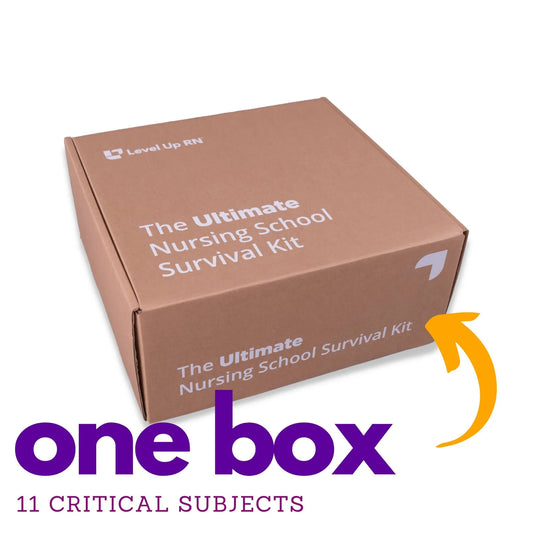Nursing Tips (659)

Ipratropium
Because ipratropium is an anticholinergic medication, educate patients that they should increase their fluid intake and suck on candy for dry mouth.
Ipratropium
Because ipratropium is an anticholinergic medication, educate patients that they should increase their fluid intake and suck on candy for dry mouth.
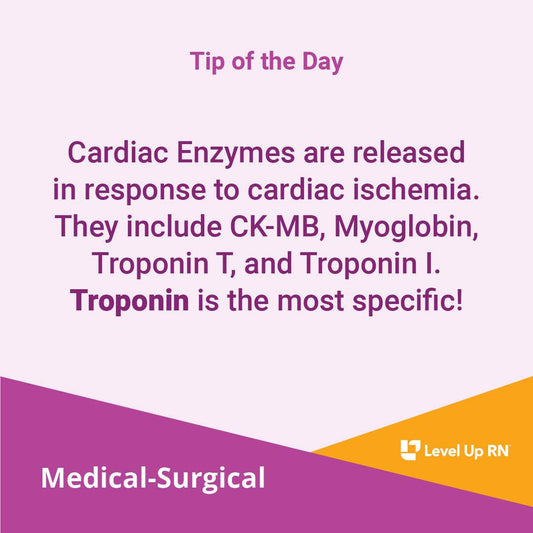
Cardiac Enzymes
Cardiac Enzymes are released in response to cardiac ischemia. They include CK-MB, Myoglobin, Troponin T, and Troponin I. Troponin is the most specific!
Cardiac Enzymes
Cardiac Enzymes are released in response to cardiac ischemia. They include CK-MB, Myoglobin, Troponin T, and Troponin I. Troponin is the most specific!

Macronutrients
Carbohydrates and protein each provide 4 kcal of energy/gram. Lipids provide 9 kcal of energy/gram.
Macronutrients
Carbohydrates and protein each provide 4 kcal of energy/gram. Lipids provide 9 kcal of energy/gram.
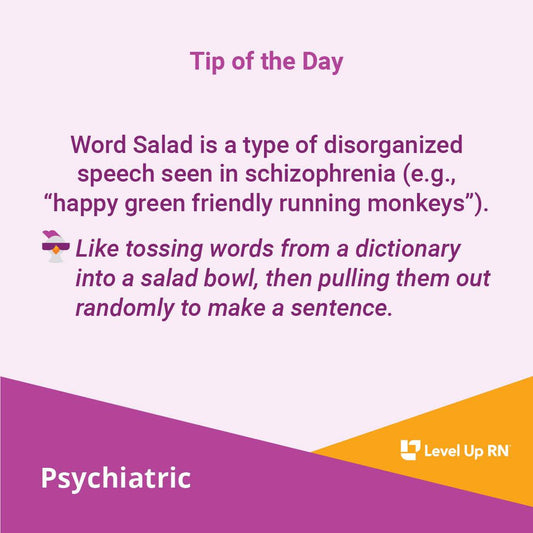
Word Salad
Word Salad is a type of disorganized speech seen in schizophrenia (e.g., "happy green friendly running monkeys").
Word Salad
Word Salad is a type of disorganized speech seen in schizophrenia (e.g., "happy green friendly running monkeys").

Acetylcysteine is Supposed to Smell Like Rotten Eggs
Acetylcysteine is a mucolytic used to treat pulmonary disorders with thick mucous secretions (e.g., cystic fibrosis). It is expected that this medication smells like rotten eggs; this is not an...
Acetylcysteine is Supposed to Smell Like Rotten Eggs
Acetylcysteine is a mucolytic used to treat pulmonary disorders with thick mucous secretions (e.g., cystic fibrosis). It is expected that this medication smells like rotten eggs; this is not an...
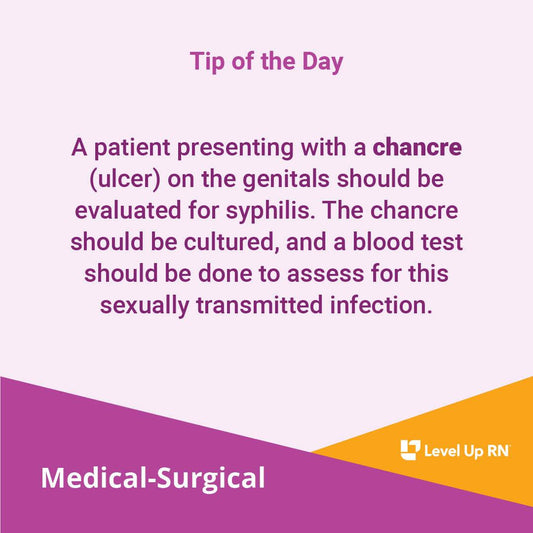
Chancre
A patient presenting with a chancre (ulcer) on the genitals should be evaluated for syphilis. The chancre should be cultured, and a blood test should be done to assess for...
Chancre
A patient presenting with a chancre (ulcer) on the genitals should be evaluated for syphilis. The chancre should be cultured, and a blood test should be done to assess for...

Psychomotor Domain of Learning
A patient who is practicing how to administer their own insulin injections is functioning under the psychomotor domain of learning, as they are not just thinking, but performing an action.
Psychomotor Domain of Learning
A patient who is practicing how to administer their own insulin injections is functioning under the psychomotor domain of learning, as they are not just thinking, but performing an action.
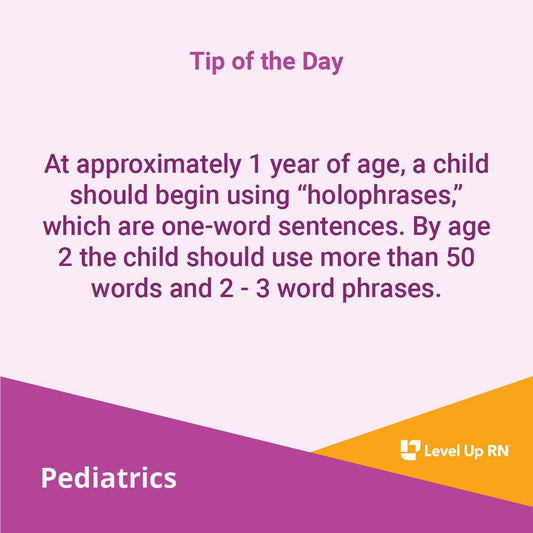
Holophrases
At approximately 1 year of age, a child should begin using "holophrases," which are one-word sentences. By age 2 the child should use more than 50 words and 2 -...
Holophrases
At approximately 1 year of age, a child should begin using "holophrases," which are one-word sentences. By age 2 the child should use more than 50 words and 2 -...
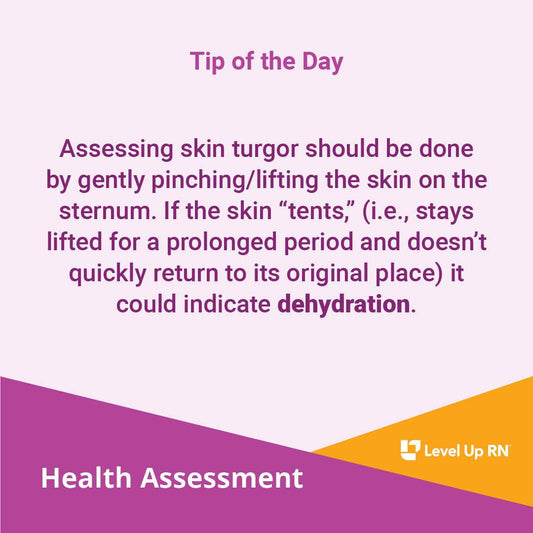
Assessing Skin Turgor
Assessing skin turgor should be done by gently pinching/lifting the skin on the sternum. If the skin "tents," (i.e., stays lifted for a prolonged period and doesn't quickly return to...
Assessing Skin Turgor
Assessing skin turgor should be done by gently pinching/lifting the skin on the sternum. If the skin "tents," (i.e., stays lifted for a prolonged period and doesn't quickly return to...

Nursing Audits
Audits are an effective way to measure and evaluate performance when carrying out quality improvement.
Nursing Audits
Audits are an effective way to measure and evaluate performance when carrying out quality improvement.
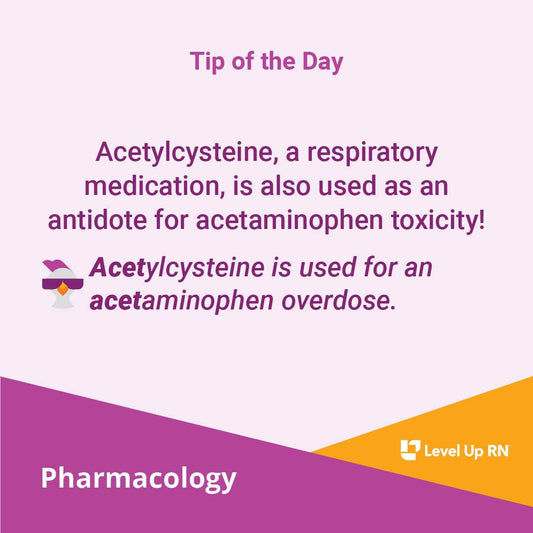
Acetylcysteine
Acetylcysteine, a respiratory medication, is also used as an antidote for acetaminophen toxicity!
Acetylcysteine
Acetylcysteine, a respiratory medication, is also used as an antidote for acetaminophen toxicity!
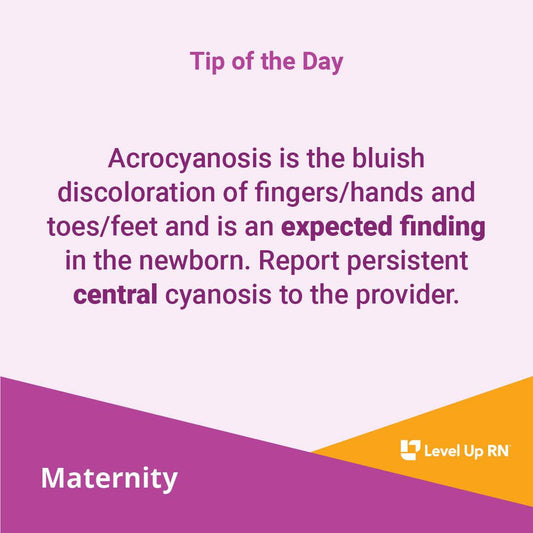
Acrocyanosis
Acrocyanosis is the bluish discoloration of fingers/hands and toes/feet and is an expected finding in the newborn. Report persistent central cyanosis to the provider.
Acrocyanosis
Acrocyanosis is the bluish discoloration of fingers/hands and toes/feet and is an expected finding in the newborn. Report persistent central cyanosis to the provider.
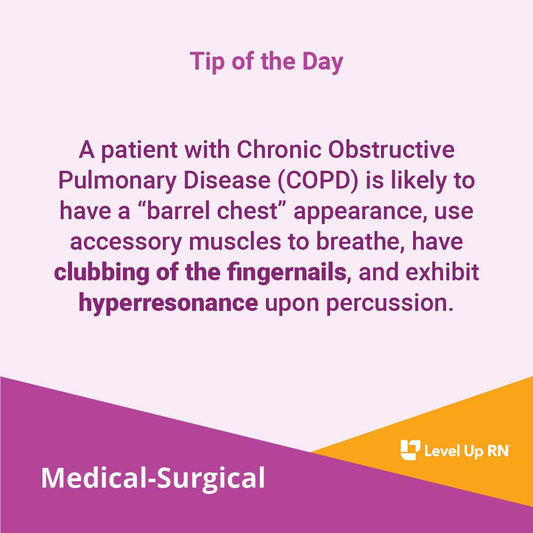
Chronic Obstructive Pulmonary Disease (COPD): Signs & Symptoms
A patient with Chronic Obstructive Pulmonary Disease (COPD) is likely to have a "barrel chest" appearance, use accessory muscles to breathe, have clubbing of the fingernails, and exhibit hyperresonance upon...
Chronic Obstructive Pulmonary Disease (COPD): Signs & Symptoms
A patient with Chronic Obstructive Pulmonary Disease (COPD) is likely to have a "barrel chest" appearance, use accessory muscles to breathe, have clubbing of the fingernails, and exhibit hyperresonance upon...
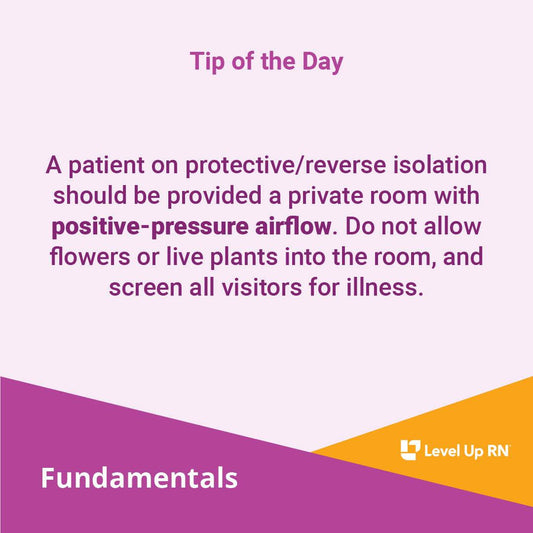
Protective/Reverse Isolation
A patient on protective/reverse isolation should be provided a private room with positive-pressure airflow. Do not allow flowers or live plants into the room, and screen all visitors for illness.
Protective/Reverse Isolation
A patient on protective/reverse isolation should be provided a private room with positive-pressure airflow. Do not allow flowers or live plants into the room, and screen all visitors for illness.
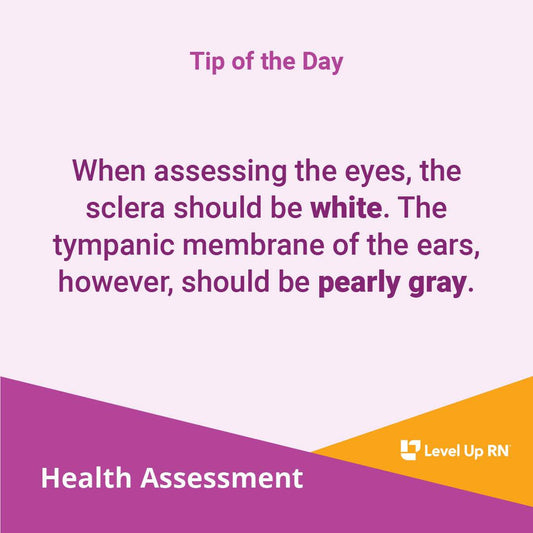
Eye and Ear Assessment
When assessing the eyes, the sclera should be white. The tympanic membrane of the ears, however, should be pearly gray.
Eye and Ear Assessment
When assessing the eyes, the sclera should be white. The tympanic membrane of the ears, however, should be pearly gray.
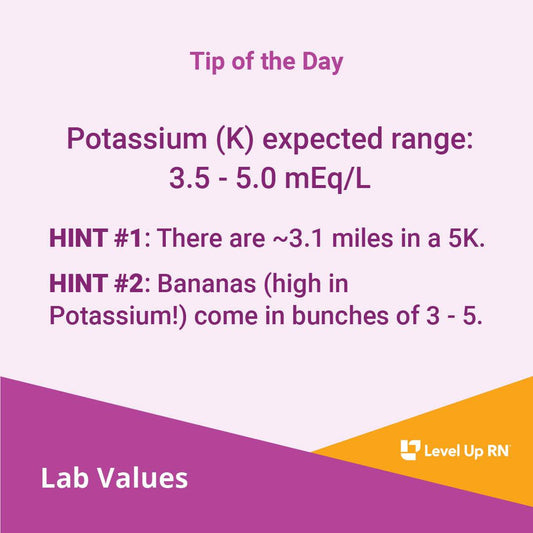
Potassium: Expected Range
Potassium (K) expected range: 3.5 - 5.0 mEq/L
Potassium: Expected Range
Potassium (K) expected range: 3.5 - 5.0 mEq/L

Dietary Considerations
Ask your patient about any dietary considerations they may have in relation to their religion rather than assuming!
Dietary Considerations
Ask your patient about any dietary considerations they may have in relation to their religion rather than assuming!
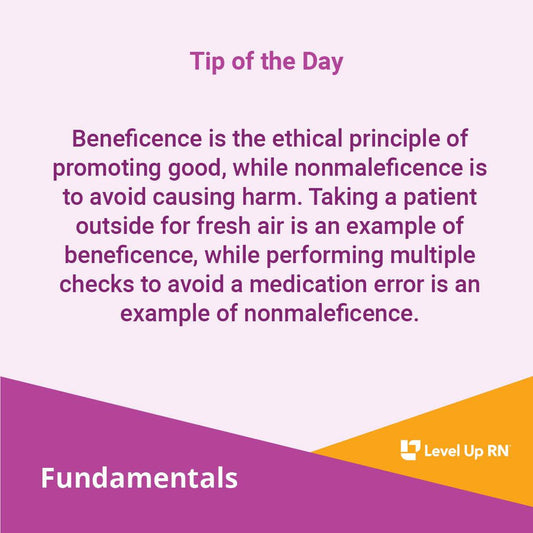
Beneficence vs. Nonmaleficence
Beneficence is the ethical principle of promoting good, while nonmaleficence is to avoid causing harm.
Beneficence vs. Nonmaleficence
Beneficence is the ethical principle of promoting good, while nonmaleficence is to avoid causing harm.
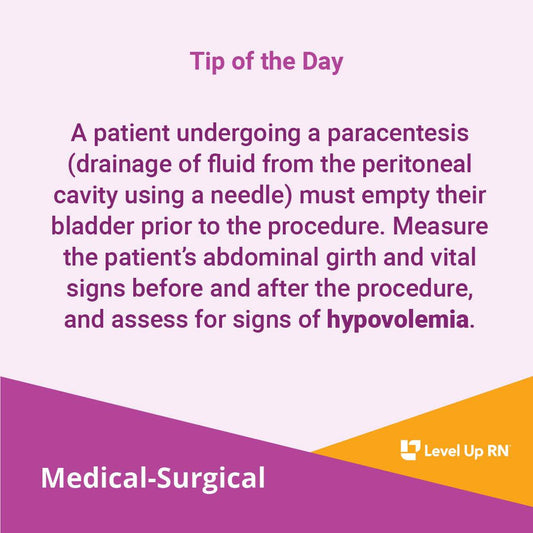
Paracentesis: Nursing Care
A patient undergoing a paracentesis (drainage of fluid from the peritoneal cavity using a needle) must empty their bladder prior to the procedure.
Paracentesis: Nursing Care
A patient undergoing a paracentesis (drainage of fluid from the peritoneal cavity using a needle) must empty their bladder prior to the procedure.
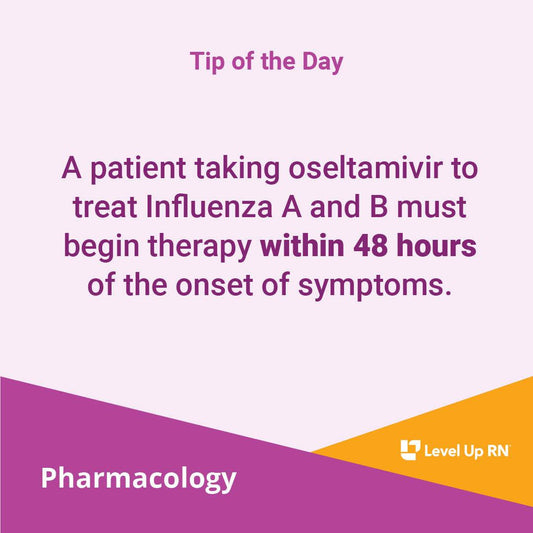
Oseltamivir
A patient taking oseltamivir to treat Influenza A and B must begin therapy within 48 hours of the onset of symptoms.
Oseltamivir
A patient taking oseltamivir to treat Influenza A and B must begin therapy within 48 hours of the onset of symptoms.
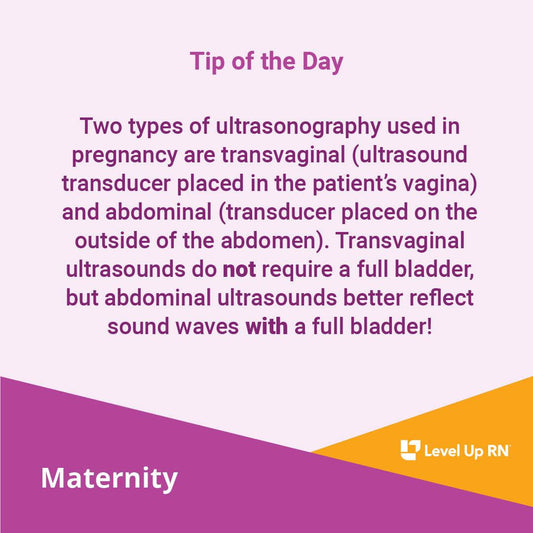
Ultrasonography
Two types of ultrasonography used in pregnancy are transvaginal (ultrasound transducer placed in the patient's vagina) and abdominal (transducer placed on the outside of the abdomen).
Ultrasonography
Two types of ultrasonography used in pregnancy are transvaginal (ultrasound transducer placed in the patient's vagina) and abdominal (transducer placed on the outside of the abdomen).
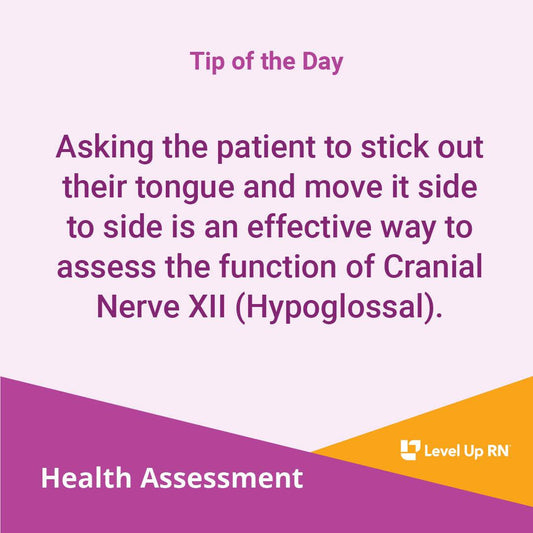
Assessing Hypoglossal Nerve Function
Asking the patient to stick out their tongue and move it side to side is an effective way to assess the function of Cranial Nerve XII (Hypoglossal).
Assessing Hypoglossal Nerve Function
Asking the patient to stick out their tongue and move it side to side is an effective way to assess the function of Cranial Nerve XII (Hypoglossal).
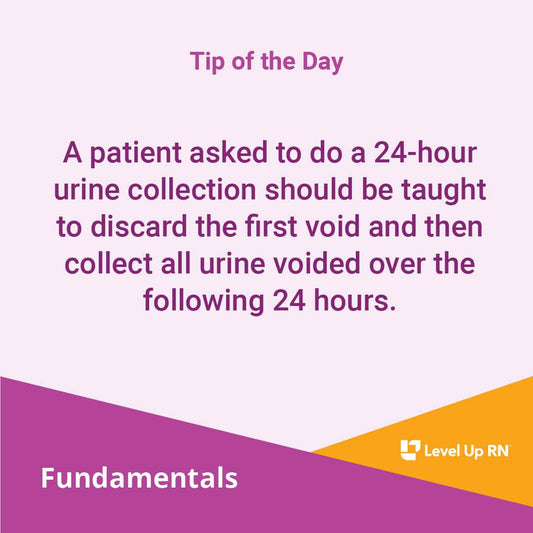
24-Hour Urine Collection
A patient asked to do a 24-hour urine collection should be taught to discard the first void and then collect all urine voided over the following 24 hours.
24-Hour Urine Collection
A patient asked to do a 24-hour urine collection should be taught to discard the first void and then collect all urine voided over the following 24 hours.

Acetaminophen: Patient Teaching
Acetaminophen, a non-opioid analgesic, can cause hepatotoxicity in high doses.
Acetaminophen: Patient Teaching
Acetaminophen, a non-opioid analgesic, can cause hepatotoxicity in high doses.
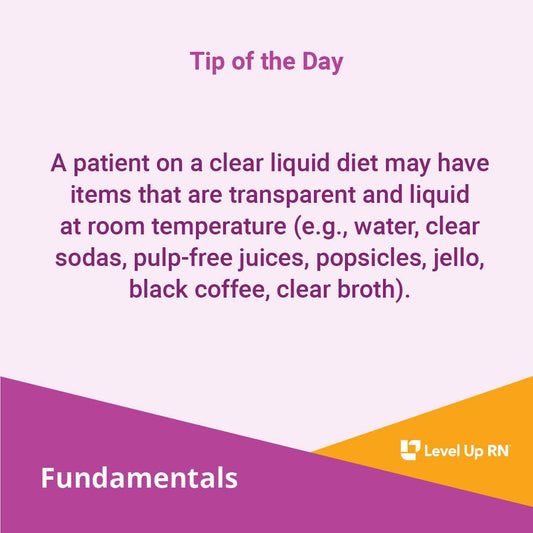
Clear Liquid Diets
A patient on a clear liquid diet may have items that are transparent and liquid at room temperature (e.g., water, clear sodas, pulp-free juices, popsicles, jello, black coffee, clear broth).
Clear Liquid Diets
A patient on a clear liquid diet may have items that are transparent and liquid at room temperature (e.g., water, clear sodas, pulp-free juices, popsicles, jello, black coffee, clear broth).
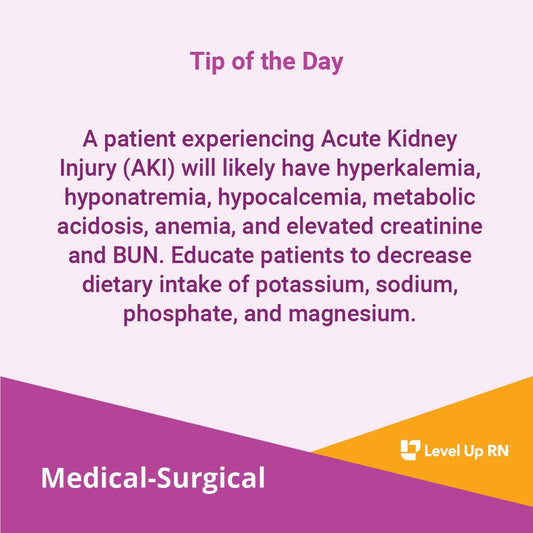
Acute Kidney Injury (AKI)
A patient experiencing Acute Kidney Injury (AKI) will likely have hyperkalemia, hyponatremia, hypocalcemia, metabolic acidosis, anemia, and elevated creatinine and BUN.
Acute Kidney Injury (AKI)
A patient experiencing Acute Kidney Injury (AKI) will likely have hyperkalemia, hyponatremia, hypocalcemia, metabolic acidosis, anemia, and elevated creatinine and BUN.

Iodism: Patient Teaching
A patient taking a strong iodine solution to treat hyperthyroidism or thyrotoxicosis in preparation for thyroidectomy should be educated as to the symptoms of iodism (e.g., metallic taste, stomatitis, severe...
Iodism: Patient Teaching
A patient taking a strong iodine solution to treat hyperthyroidism or thyrotoxicosis in preparation for thyroidectomy should be educated as to the symptoms of iodism (e.g., metallic taste, stomatitis, severe...
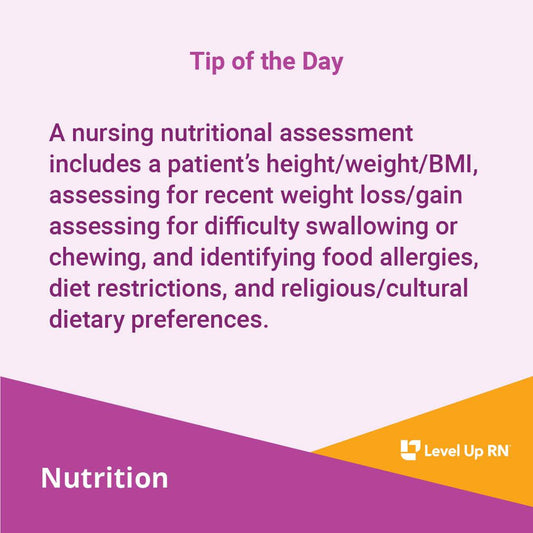
Nursing Nutritional Assessment
A nursing nutritional assessment includes a patient's height/weight/BMI, assessing for recent weight loss/gain assessing for difficulty swallowing or chewing, and identifying food allergies, diet restrictions, and religious/cultural dietary preferences.
Nursing Nutritional Assessment
A nursing nutritional assessment includes a patient's height/weight/BMI, assessing for recent weight loss/gain assessing for difficulty swallowing or chewing, and identifying food allergies, diet restrictions, and religious/cultural dietary preferences.
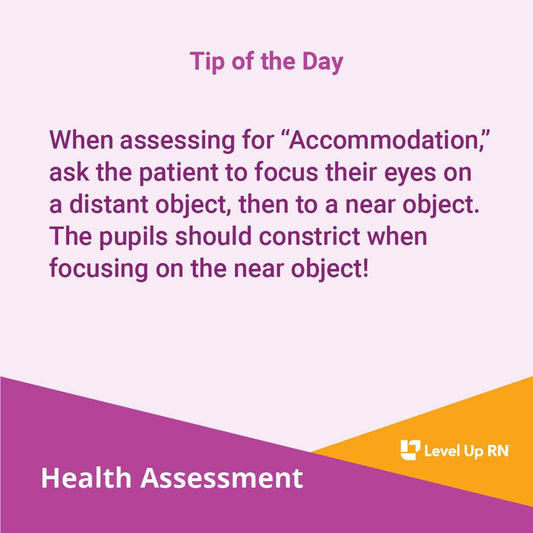
Assessing for Accommodation
When assessing for "Accommodation," ask the patient to focus their eyes on a distant object, then to a near object. The pupils should constrict when focusing on the near object!
Assessing for Accommodation
When assessing for "Accommodation," ask the patient to focus their eyes on a distant object, then to a near object. The pupils should constrict when focusing on the near object!

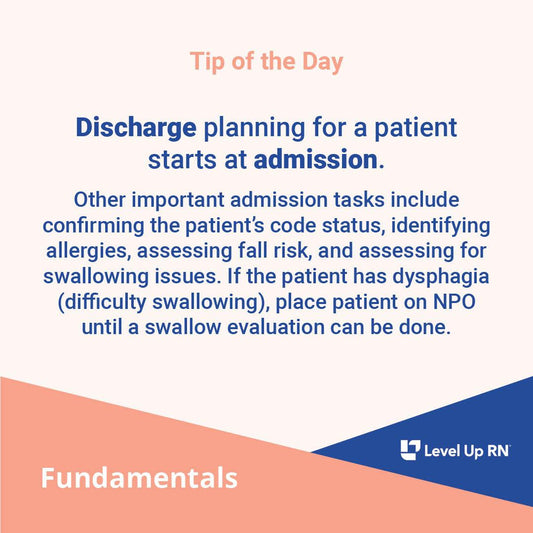
Admission Tasks
Discharge planning for a patient starts at admission. Other important admission tasks include confirming the patient's code status, identifying allergies, assessing fall risk, and assessing for swallowing issues.
Admission Tasks
Discharge planning for a patient starts at admission. Other important admission tasks include confirming the patient's code status, identifying allergies, assessing fall risk, and assessing for swallowing issues.
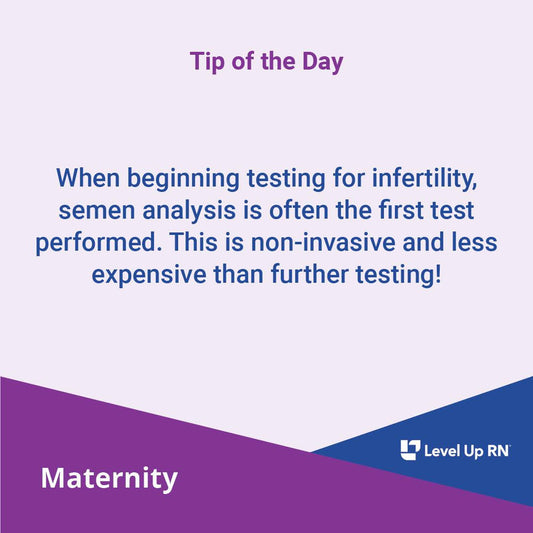
Testing for Infertility
When beginning testing for infertility, semen analysis is often the first test performed. This is non-invasive and less expensive than further testing!
Testing for Infertility
When beginning testing for infertility, semen analysis is often the first test performed. This is non-invasive and less expensive than further testing!

Treatment for Infertility
Treatment for infertility is unique to the individual, but some treatments include: Intrauterine Insemination (IUI), In Vitro Fertilization (IVF), Embryo Transfer (ET), the use of donor eggs/sperm/embryo, and the use...
Treatment for Infertility
Treatment for infertility is unique to the individual, but some treatments include: Intrauterine Insemination (IUI), In Vitro Fertilization (IVF), Embryo Transfer (ET), the use of donor eggs/sperm/embryo, and the use...
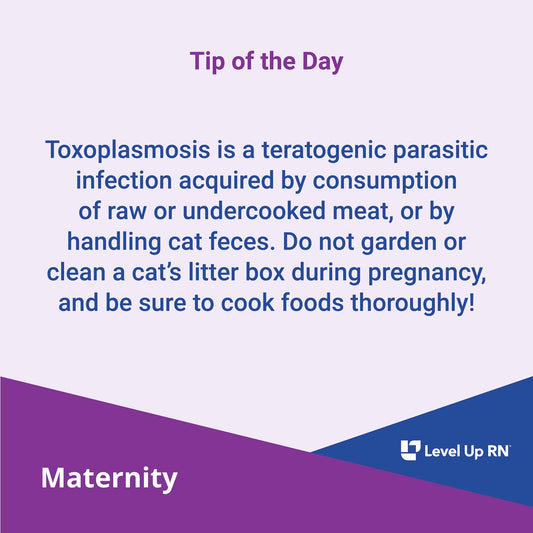
Toxoplasmosis
Toxoplasmosis is a teratogenic parasitic infection acquired by consumption of raw or undercooked meat, or by handling cat feces.
Toxoplasmosis
Toxoplasmosis is a teratogenic parasitic infection acquired by consumption of raw or undercooked meat, or by handling cat feces.
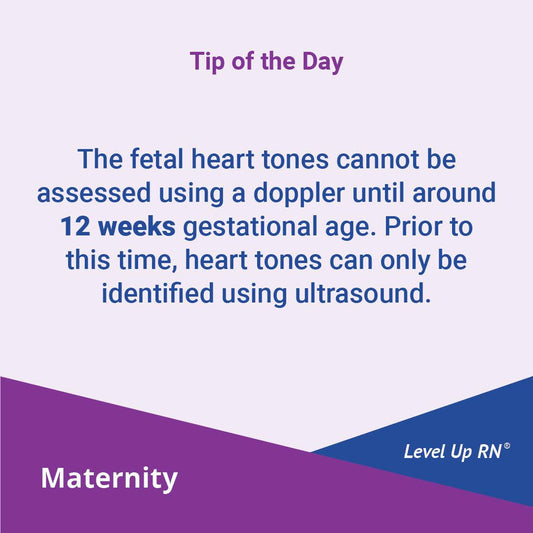
Assessing Fetal Heart Tones
The fetal heart tones cannot be assessed using a doppler until around 12 weeks gestational age. Prior to this time, heart tones can only be identified using ultrasound.
Assessing Fetal Heart Tones
The fetal heart tones cannot be assessed using a doppler until around 12 weeks gestational age. Prior to this time, heart tones can only be identified using ultrasound.
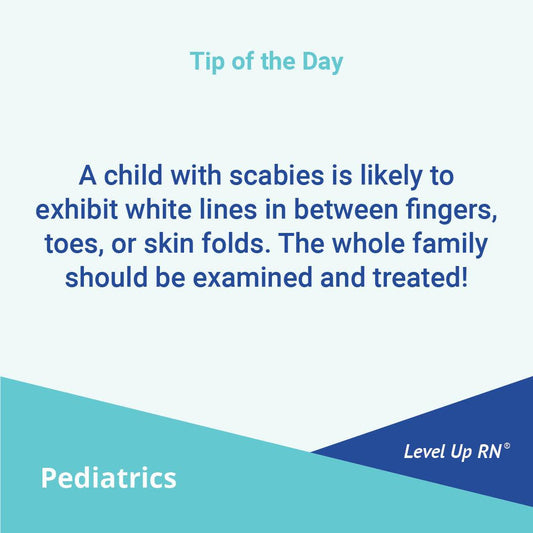
Scabies in Children
A child with scabies is likely to exhibit white lines in between fingers, toes, or skin folds. The whole family should be examined and treated!
Scabies in Children
A child with scabies is likely to exhibit white lines in between fingers, toes, or skin folds. The whole family should be examined and treated!
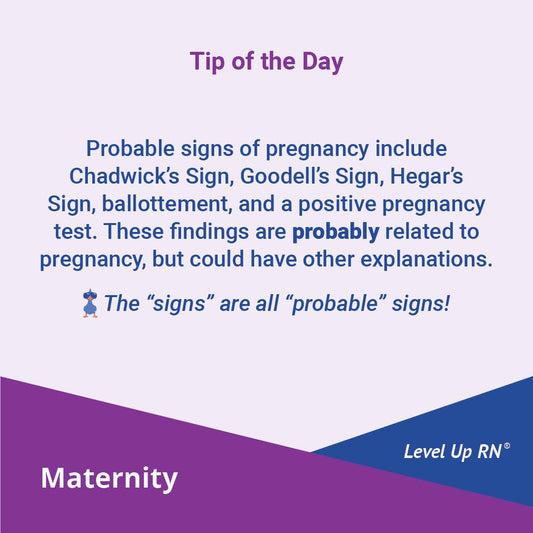
Probable Signs of Pregnancy
Probable signs of pregnancy include Chadwick's Sign, Goodell's Sign, Hegar's Sign, ballottement, and a positive pregnancy test. These findings are probably related to pregnancy, but could have other explanations.
Probable Signs of Pregnancy
Probable signs of pregnancy include Chadwick's Sign, Goodell's Sign, Hegar's Sign, ballottement, and a positive pregnancy test. These findings are probably related to pregnancy, but could have other explanations.
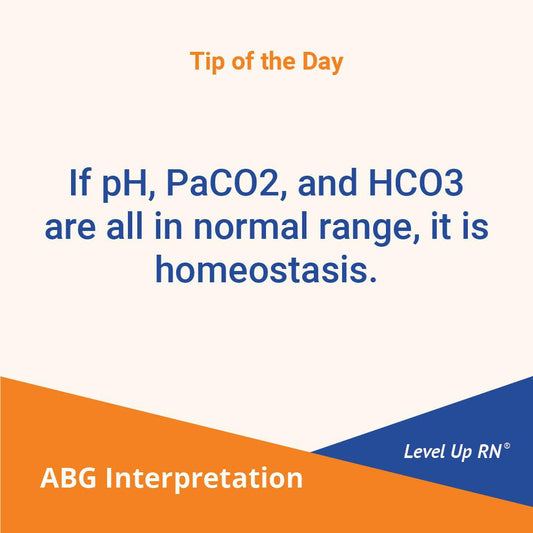
Homeostasis
If pH, PaCO2, and HCO3 are all in normal range, it is homeostasis.
Homeostasis
If pH, PaCO2, and HCO3 are all in normal range, it is homeostasis.
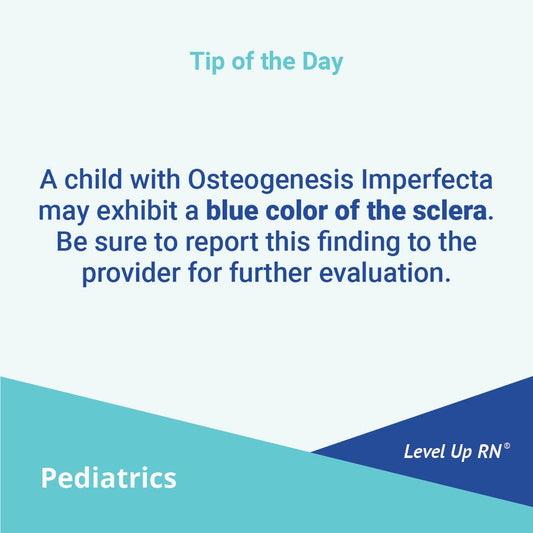
Osteogenesis in Children
A child with Osteogenesis Imperfecta may exhibit a blue color of the sclera. Be sure to report this finding to the provider for further evaluation.
Osteogenesis in Children
A child with Osteogenesis Imperfecta may exhibit a blue color of the sclera. Be sure to report this finding to the provider for further evaluation.
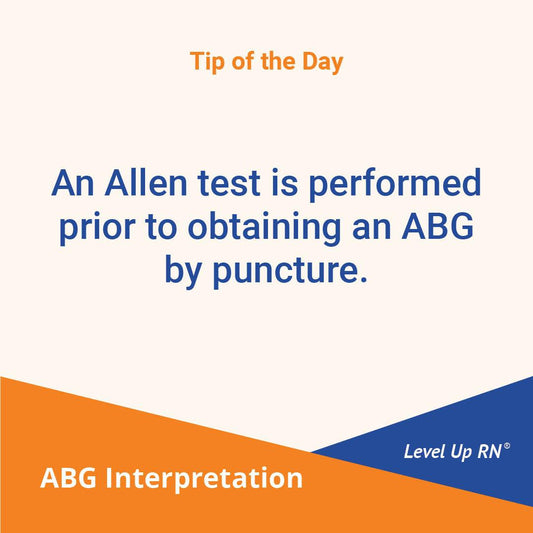
Allen Test
An Allen test is performed prior to obtaining an ABG by puncture.
Allen Test
An Allen test is performed prior to obtaining an ABG by puncture.
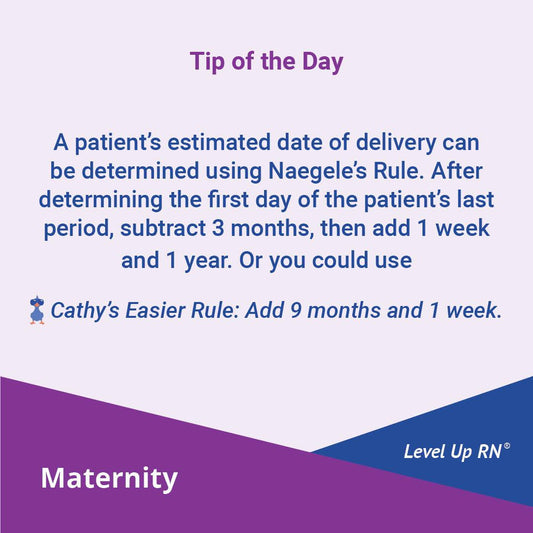
Naegele's Rule
A patient's estimated date of delivery can be determined using Naegele's Rule. After determining the first day of the patient's last period, subtract 3 months, then add 1 week and...
Naegele's Rule
A patient's estimated date of delivery can be determined using Naegele's Rule. After determining the first day of the patient's last period, subtract 3 months, then add 1 week and...
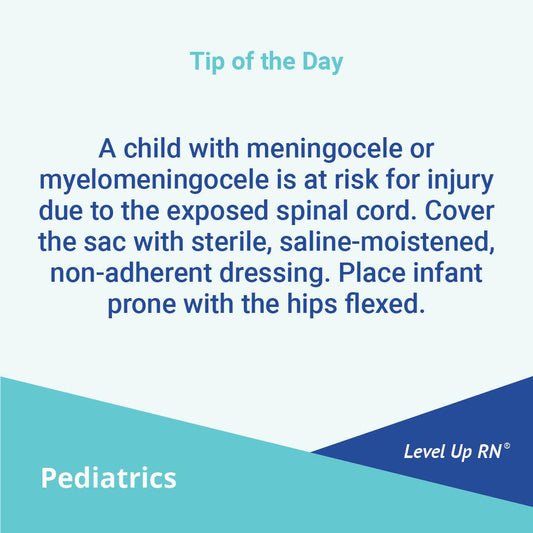
Meningocele and Myelomeningocele in Children
A child with meningocele or myelomeningocele is at risk for injury due to the exposed spinal cord. Cover the sac with sterile, saline-moistened, non-adherent dressing. Place infant prone with the...
Meningocele and Myelomeningocele in Children
A child with meningocele or myelomeningocele is at risk for injury due to the exposed spinal cord. Cover the sac with sterile, saline-moistened, non-adherent dressing. Place infant prone with the...
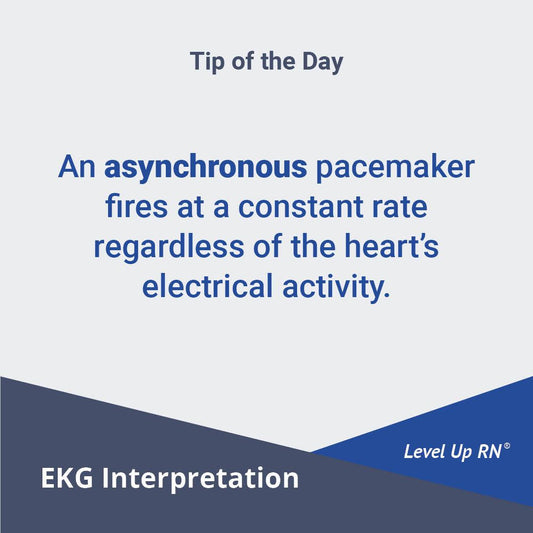
Asynchronous Pacemaker
An asynchronous pacemaker fires at a constant rate regardless of the heart's electrical activity.
Asynchronous Pacemaker
An asynchronous pacemaker fires at a constant rate regardless of the heart's electrical activity.
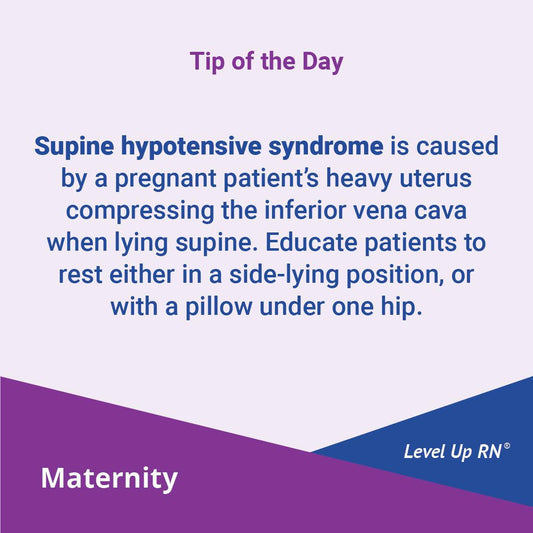
Supine Hypotensive Syndrome
Supine hypotensive syndrome is caused by a pregnant patient's heavy uterus compressing the inferior vena cava when lying supine. Educate patients to rest either in a side-lying position, or with...
Supine Hypotensive Syndrome
Supine hypotensive syndrome is caused by a pregnant patient's heavy uterus compressing the inferior vena cava when lying supine. Educate patients to rest either in a side-lying position, or with...
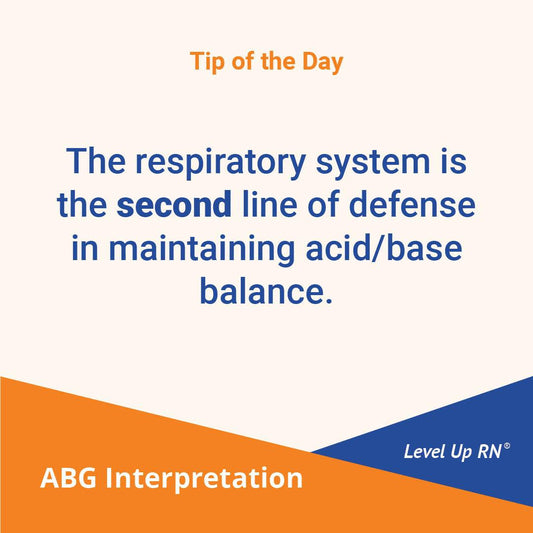
The Respiratory System and Acid/Base Balance
The respiratory system is the second line of defense in maintaining acid/base balance.
The Respiratory System and Acid/Base Balance
The respiratory system is the second line of defense in maintaining acid/base balance.
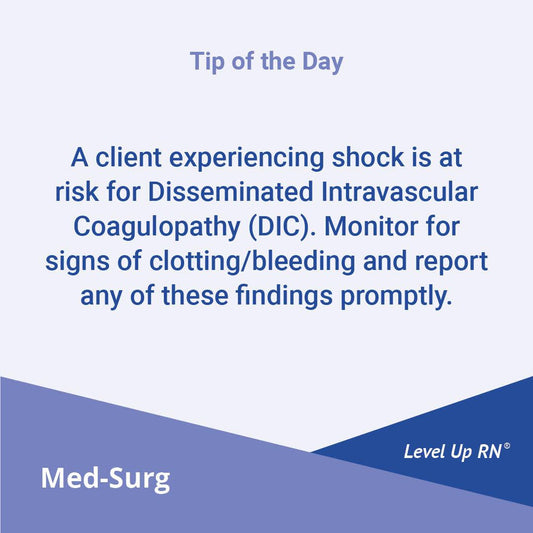
Disseminated Intravascular Coagulopathy (DIC)
A client experiencing shock is at risk for Disseminated Intravascular Coagulopathy (DIC). Monitor for signs of clotting/bleeding and report any of these findings promptly.
Disseminated Intravascular Coagulopathy (DIC)
A client experiencing shock is at risk for Disseminated Intravascular Coagulopathy (DIC). Monitor for signs of clotting/bleeding and report any of these findings promptly.
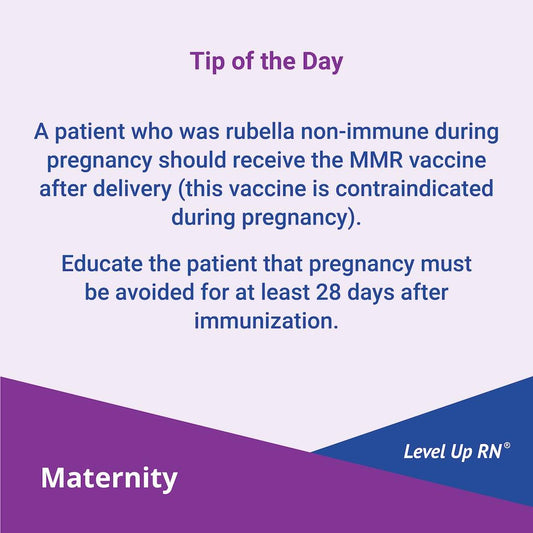
MMR Vaccine and Pregnancy
A patient who was rubella non-immune during pregnancy should receive the MMR vaccine after delivery (this vaccine is contraindicated during pregnancy). Educate the patient that pregnancy must be avoided for at...
MMR Vaccine and Pregnancy
A patient who was rubella non-immune during pregnancy should receive the MMR vaccine after delivery (this vaccine is contraindicated during pregnancy). Educate the patient that pregnancy must be avoided for at...
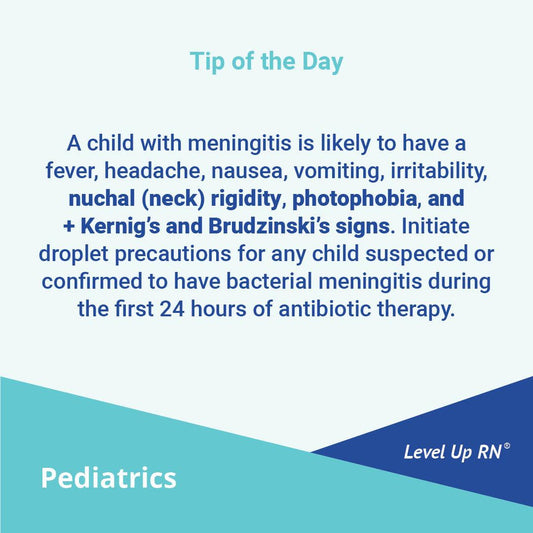
Meningitis in Children
A child with meningitis is likely to have a fever, headache, nausea, vomiting, irritability, nuchal (neck) rigidity, photophobia, and + Kernig's and Brudzinski's signs.
Meningitis in Children
A child with meningitis is likely to have a fever, headache, nausea, vomiting, irritability, nuchal (neck) rigidity, photophobia, and + Kernig's and Brudzinski's signs.
Filter Articles
Shop
The Ultimate Nursing School Survival Kit - with Flashables and Membership
4.875 / 5.0
(240) 240 total reviews
Regular price $349.95Regular priceUnit price / per$817.95Sale price $349.95SaleVideos by Subject
Tips & More
Exam Information
Subscribe


